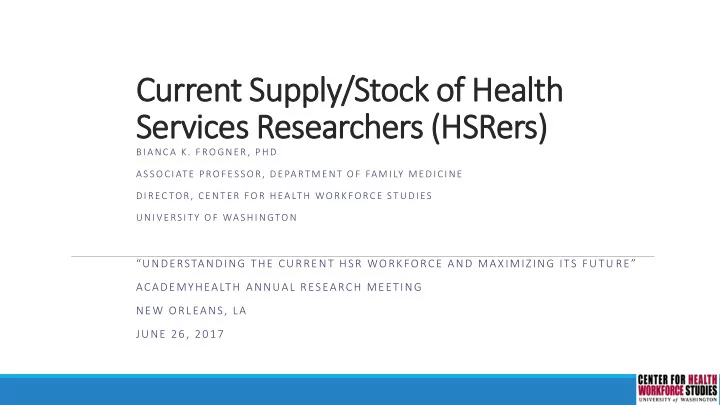

Current Supply/Stock of Health Services Researchers (HSRers) BIANCA K. FROGNER, PHD ASSOCIATE PROFESSOR, DEPARTMENT OF FAMILY MEDICINE DIREC TOR, CENTER FOR HEALTH WORKFORCE STUDIES UNIVERSITY OF WASHINGTON “UNDERSTANDING THE CURRENT HSR WORKFORCE AND MAXIMIZING ITS FUTU RE” ACADEMYHEALTH ANNUAL RESEARCH MEETING NEW ORLEANS, LA JUNE 26, 2017
Study Overview Primary Objectives 1) To update (and expand on) prior studies on the stock/supply of health services researchers (HSRers) to gauge whether the field is growing or shrinking 2) To examine the educational pipeline to identify how many students are training in HSR-related fields, or could potentially be an HSRer 3) To discuss how the HSR supply has been changing (e.g., sociodemographics, work location, areas of concentration) and the challenges of defining the field Study Design Exploratory descriptive analysis of multiple data sources on individuals involved in HSR in the United States between January 1, 2010 to December 31, 2015
Data Sources Study Investigators Other HSRers NIH Research Portfolio Online AcademyHealth Reporting Tools (RePORTER) ◦ Membership database ◦ ARM 2015 participants AHRQ Grants On-Line Database LinkedIn (as of July 2016) Health Services Research Projects in Progress (HSRProj) ResearchGate (as of July 2016) Authors Education Pipeline PubMed using Medical Subject Integrated Postsecondary Education Headings (MeSH) and selected Data System (IPEDS) journals
Table 1: Number of Health Services Researchers Identified from Sources SOURCES COUNT AcademyHealth 2015 Annual Research Meeting Presenters 5,792 Select Journals (First three authors published from 2010 to 2015) Health Services Research (714 articles) 1,500 Medical Care (1209 articles) 2,580 Sponsored Projects (Investigators) Compared to: NIH RePORTER and AHRQ GOLD (16,041 grants) 1 5,031 5,000 in 1995 1 HSRProj 2 6,630 11,596 in 2007 2 NIH, AHRQ, VA sponsoring agencies 4,740 At least 25% increase Other sponsoring agencies 1,890 Duplicated count 21,533 Unduplicated count to compare with 11,596 HSRers found in 2011 by McGinnis & Moore (ARM, 14,526 Select Journals, HSRProj) Unduplicated count expanded (including NIH RePORTER, AHRQ GOLD) 16,743 AcademyHealth Membership Directory (as of 7/31/2016) All members in United States 4,343 Type of work identified as “Health Services Research” 1,395 Secondary type of work identified as “Health Services Research” 163 LinkedIn.com Self- identified skill of “Health Services Research” in United States 6,126 Members of “Health Services Research Group” 6,331 AcademyHealth Group 3,206 ResearchGate.net Researchers in “Healthcare Policy and Economics” in United States 20,300 1. Field, M.J., R.E. Tranquada, and J.C. Feasley, (eds.). 1995. Health Services Research: Work Force and Educational Issues. Washington, DC: National Academies Press. 2. McGinnis, S., J. Moore, “The Health Services Research Workforce: Current Stock,” Health Services Research , 2009, 44(6): 2214-26.
Table 2: Article Count by Key Medical Subject Headings (MeSH) as Major Topic, 2010-2015 Medical Subject Headings (MeSH) as Major Topic Article Count Translational Research 3,026 Health Care Category 754,001 Environment and Public Health 308,682 Health Care Economics and Organizations 124,829 Health Care Facilities, Manpower, and Services 298,253 Health Care Quality, Access, and Evaluation 314,334 Health Services Research 12,184 Delivery of Health Care 148,708 Ethics 12,495 Quality Assurance, Health Care 26,595 Quality of Health Care 188,176 Health Services Administration 230,494 Population Characteristics 115,331
Figure 1: Industry in Which AcademyHealth Members Identified as HSRers Work (N=1395) Pharmaceutical, 0.2% Health plan/insurer, 0.5% State/local Not identified , 19.2% government, 0.9% "Other", 1.1% Foundation, 1.9% Association, 2.2% Universities , 50.8% Consulting, 2.2% Corporation, 3.2% Hospital/healthcare provider, 3.2% Federal government, 3.9% Research/policy org/not a university, 10.7%
Figure 2: Diversity of Pipeline in Core HSR-Related Fields, 2010/11 v. 2014/15 100% 8% 9% 10% Non-citizen 14% 90% 5% 7% 9% 1% 2% Unknown race/ethnicity 1% 80% 8% 16% 11% 10% Multi-race 70% 0% 18% 10% 14% 14% Hawaiian Island/Pacific Islander 60% 13% Non-Hispanic 50% American Indian/Alaskan Native Educational Pipeline: 40% Approximately 1 HSR student for Asian 52% every 5 to 6 HSRer 50% 30% 50% Black/African American 41% 20% White 10% Hispanic, Any Race 7% 6% 6% 5% 0% N=14,544 N=16,339 N=415 N=578 2010-2011 2014-2015 2010-2011 2014-2015 Master’s Degree Doctoral Degree
Looking Forward Conclusion: The stock of HSRers is growing and currently less diverse than population. Need better definition of boundaries and better methods to track HSR workforce of the future, which appears to be growing and more diverse. Areas for further discussion: 1. What is the goal of counting HSRers – meeting demand of employers/stakeholders, advocate for funding, expand AcademyHealth’s reach, strengthen the pipeline of students? 2. What makes for a “ HSRer ”? What are the topic or skill boundaries? 3. How do we capture HSRers who do not publish in peer-reviewed journals or do not seek external funding from federal agencies and foundations? 4. How do we better track our HSR workforce? Could we better align and connect datasets?
Questions? Contact: BIANCA K. FROGNER, PHD ASSOCIATE PROFESSOR, DEPARTMENT OF FAMILY MEDICINE DIREC TOR, CENTER FOR HEALTH WORKFORCE STUDIES BFROGNER@UW.EDU UW CENTER FOR HEALTH WORKFORCE STUDIES HT TPS://DEPTS.WASHINGTON.EDU/FAMMED/CHWS/ @UWCHWS
Recommend
More recommend